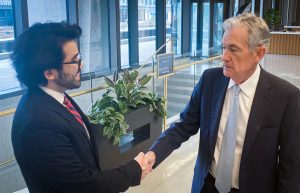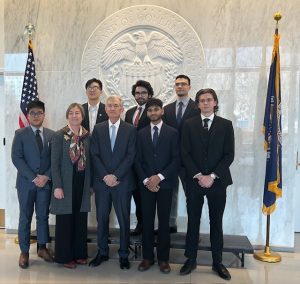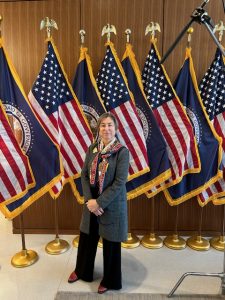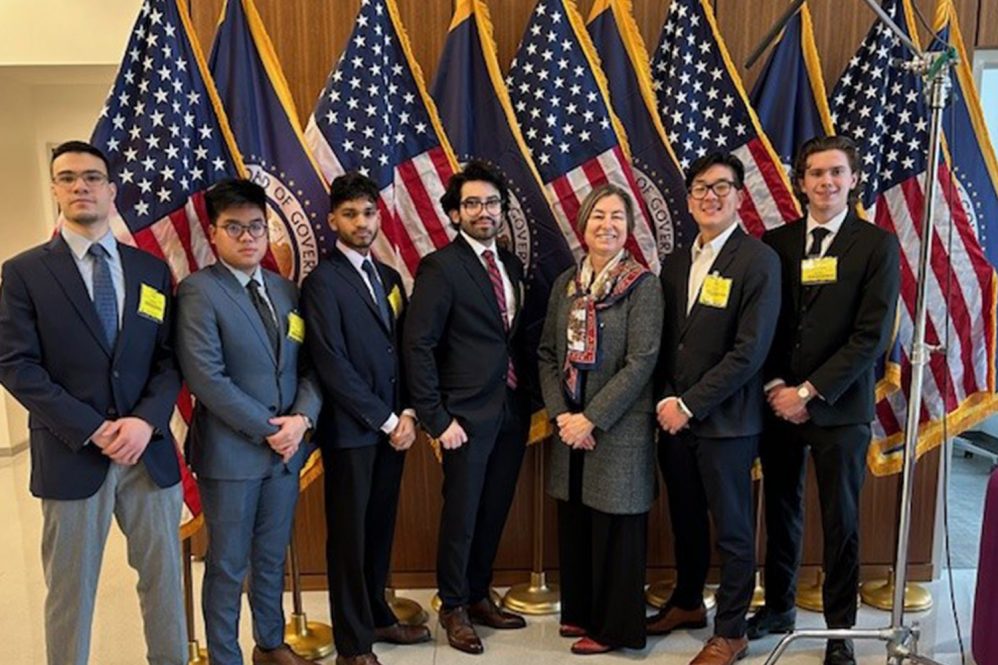No light show preceded his entrance, no pyrotechnics exploded, and no theatrical smoke poured into the air, but to the group of UConn Stamford students who met U.S. Federal Reserve Chair Jerome H. Powell, he still was a rock star.
Many of the students used the word “surreal” to convey what it was like last month to stand alongside the man responsible for guiding monetary policy in the United States, the person responsible for interest rates, inflation, and just generally keeping the country as close to a booming economy as possible.

They also say he’s shorter than they thought, has an unexpected sense of humor, and knows of UConn – or at least enough to say, “Go Huskies” in conversation.
“Visiting the Federal Reserve, for an economist, is like a doctor visiting the top hospital in the country. Being at the nation’s central bank, watching the Federal Open Market Committee in action, and meeting the head of it all was an experience we will never forget,” says Félix Velázquez ’24 (CLAS).
The group of seven, plus their advisor Natalia Smirnova ’04 Ph.D., an associate professor-in-residence in the Department of Economics, traveled to Washington, D.C., in early February to cap their year-long participation in the College Fed Challenge, a nationwide competition for budding economists. Since the pandemic, it’s been held virtually.
In honor of the competition’s 20th anniversary, the Challenge extended invitations to meet Powell to all 108 collegiate teams, no matter how well they placed. UConn Stamford was one of only 31 that made the trek.
It was grouped in the competition with schools in the New York area, since Fairfield County falls under the auspices of the Federal Reserve Bank of New York. The team from Storrs, which did not venture to Washington, was among those in the Boston area competition, from areas served by the Federal Reserve Bank of Boston.
“For me as an educator this whole experience of participating in a national competition is a very big learning opportunity,” Smirnova says. “It’s great if we advance to the second and third rounds, but the main thing is participating. That’s where learning actually happens.”
At UConn Stamford, members of the Challenge team, which has been around since 2016, enroll in two preparatory classes, the first in the spring semester and the second in the fall, to learn concepts about monetary policy and eventually divide into teams to study things like gross domestic product, the housing and labor markets, and other economic variables more in-depth.

Over the course of 10 months they watch the U.S. economy, paying attention to all its highs and lows, learning how it fits together, before filming a 15-minute video to submit to the Challenge in October. Only five students are allowed on camera, although any number of students can participate in the research.
“The Federal Reserve has different tools and resources to control the economy,” Velázquez, an economics major, explains. “What we do in the project is act as the Federal Open Market Committee, which votes on various proposals, and take all the latest data on GDP, employment, inflation, and decide what we can do to affect monetary policy to maintain maximum employment and price stability.”
Noah Park ’24 (SFA), a digital media & design major, says he studied the housing market and looked at metrics like mortgage and delinquency rates: “At group meetings, I’d talk about how mortgage rates are rising and are double what they were since the 2008 recession. And maybe someone from the inflation group would step in and explain why that is.”
But from week to week, data changed. China might have released its unemployment rate or maybe a military conflict started, global issues that affect how things are done here at home.
The students say they often spent weekends working on the project, designing graphs and charts to bolster their arguments, and trying to figure out how the latest world crisis would impact the U.S. economy, only to have their work nullified the next time a new data metric was released.
“There were times I was really frustrated because I worked so long on part of the project. Everything was ready and then we’d have to scrap everything and redo it again,” Kiet Tran ’26 (BUS), a marketing management major, says.
“But I felt like it was a healthy frustration,” adds Kevin Jankowski ’25 (BUS), a financial management major. “It was the frustration of continued learning. The data was constantly updating and refreshing, which is why it was important to understand the sector you were studying.”
Still, he notes, even though they were using a variety of University and personal resources, it was like working with a handicap compared to the depth of the resources and speed of them available to economists at the Federal Reserve.
That made it fun, Jankowski says, to see if the group’s idea or decision lined up with what the professionals did, how close they were or how far off.
“Group projects are not something students look forward to in school, so it’s a real breath of fresh air to move into this group project because you all chose to be in the group. You all want the same thing. You all have the same goals. Everyone’s willing to work hard. Meeting the other students from other schools in Washington was also a beneficial experience because we got to see how the challenges were run differently at every school,” he adds.
Ivy League schools might have a hundred applicants seeking to be one of 30 or 40 members of their school’s Challenge team, whereas other schools might struggle to recruit the required five students.
At UConn Stamford, the 2023 Challenge students are seeking to form an Economic Research and Policy Council club to increase participation. Already this spring, 14 students, double the size of last year’s group, are enrolled in the 2024 Challenge.

Smirnova says students of any major can contribute; Park, with his DMD skills, in addition to helping with the analysis as an economics minor, brought video skills to the mix.
He got interested in economics when he started studying the 2008 recession, he says. Velázquez gained an interest as a child in Venezuela when the economy faced hyperinflation, which affected his family’s business and prompted them to move here.
Daniel Barreto ’24 (CLAS) started studying economics when he saw his parents lose money on investments.
“I didn’t know why they did, and I didn’t even know about the Federal Reserve back then. Quickly, I learned that knowing more about what goes on, beyond just the financial markets, is very helpful for your investments to do better,” he says.
Jankowski describes the economy as like a line of dominoes.
“If they set rates up, mortgage rates will go up and what happens next? People are less likely to buy homes. If people are not as willing to buy homes and rates are high, they’re probably not going to take out construction contracts, so developments are going to be low. There are issues with supply housing to begin with. One decision affects so many decisions later on,” he says.
Quite simply, the health of the economy plays a part in almost every aspect of life, whether leasing an apartment, buying a new vehicle, even saving for a house. That’s why the students stress the importance of staying on top of what’s going on, even if it’s not in one’s wheelhouse.
“Even if you’re not interested in the numbers just pay attention to the story of what’s going on,” says Adrien Vincent ’25 (BUS), who’s studying financial management. “Wars can affect the supply chain which can affect grocery story prices. Just read a simple news article or even a headline. You can see how it affects your everyday life.”
That’s why the students say everyone should know three things:
“They should know about inflation,” Vincent says.
“If you want to get started in economics, start by asking yourself how you can reach your own personal growth with the limited resources you have,” Park adds.
“Economics is not politics,” Velázquez says. “The Federal Reserve is a governmental institution, not at all a political institution. In the upcoming election, the candidates might talk about what monetary policies they’re going to enact. But nothing could be further from the truth. The Federal Reserve is an independent institution. It’s the bank of the banks and no other power in the government can overpower it.”
He also notes that economics started as a branch of philosophy only about 150 years ago.
“The principal thought of economics is that we as humans have unlimited wants, but there are limited resources,” Velázquez says. “Economists come up with ideas about how to make it fair for everyone. That’s the difference between economics and finance. In finance, you make money for yourself or someone else. In economics, you work to improve outcomes for everyone.”
The UConn Stamford College Fed Challenge team traveled to Washington, D.C., thanks to generous support from the Department of Economics and the dean’s office in the College of Liberal Arts and Sciences, the School of Business, and the UConn Stamford administration.



